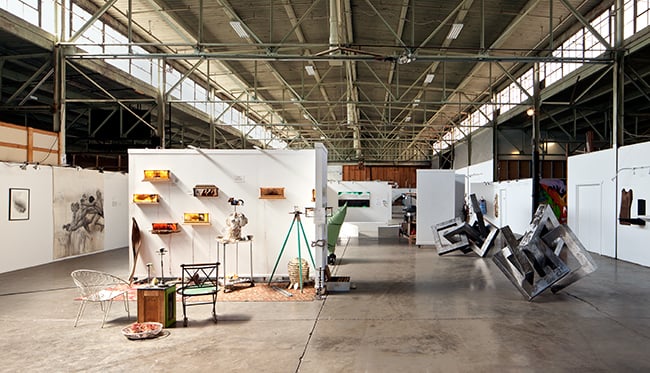
July 15, 2013
Oakland Made: The People Behind Oakland’s Emerging Creative Economy
A small army of artists, designers, and makers has set up shop in the once-bustling factories and warehouses here. Will the city finally take them seriously as a potent urban force?

The Poplar Gallery is a 6,000-square-foot space inside Oakland’s sprawling six-acre American Steel Studios complex.
Henrik Kam
There are many Oaklands. There’s the Oakland that appeared on the blazing red cover of the New York Times Magazine last August, depicting a bastion of radicalism fueled by the Occupy movement. There’s the massive port, where cargo ships unload huge stacks of containers beneath cranes that evoke Star Wars’ AT-AT Walkers. There’s the Oakland where violent crime stymies a short-staffed police force, and where an officer shot an unarmed 22-year-old African-American man in 2009, inciting riots. There’s also an Oakland of country clubs and mansions, and a wilder Oakland, with open-space parks forming a redwood-forested chain from north to south.
If Oakland’s sense of place was at some point weak (recall Gertrude Stein’s famous description of it as a city with “no there there”) it’s quite the opposite now. While outsiders may think of it as a satellite of San Francisco, residents don’t orient themselves to the bigger and more prosperous metropolis across the bay. Local pride is fervent, and numerous efforts are under way by both the city and its citizens to make Oakland as much of a cultural destination as its neighbor. Among its existing assets, the city has a booming population of working artists, designers, and makers, many of whom have been pushed from more expensive locales to the cheap, abundant acreage of Oakland’s post-industrial flatlands. In the West Oakland neighborhood, where warehouses and heavy machinery sit idle, industrial-art makers have found their own idyll, and are becoming a force in a new creative economy.
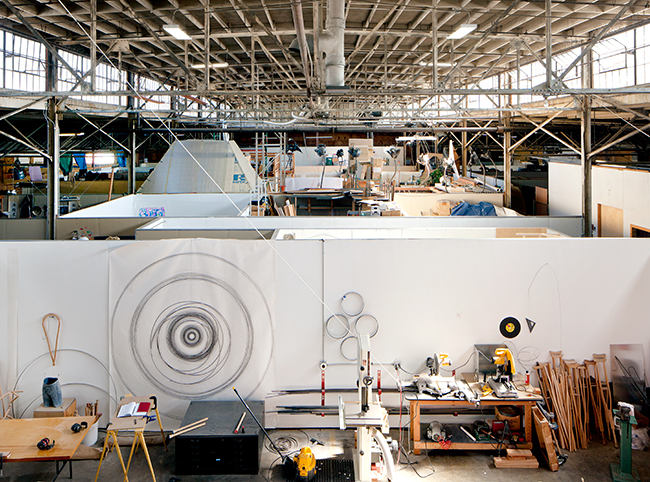
West Oakland’s old factories and warehouses have provided perfect spaces for the neighborhood’s burgeoning maker scene.
Henrik Kam
The West Oakland Industrial Arts Corridor, as it’s become known, centers on the lushly landscaped Mandela Parkway, which cuts a wide diagonal from the West Oakland BART (Bay Area Rapid Transit) station to Emeryville, a one-square-mile mini city perhaps best known as the home of Pixar Animation Studios. This sunbathed street hardly sees a shadow during the day, with only long, low warehouses and mid-rise residential buildings lining its edges.
Despite the parkway’s name, “peaceful” is not likely the first word that comes to mind when locals are asked about the area. It was a thriving neighborhood in the late nineteenth and early twentieth centuries, home to the westernmost stop on the transcontinental railroad and a vibrant jazz and blues culture emanating from the large African-American population. But by the 1960s, the decline of the railroad industry, the construction of a new military base, and the introduction of public housing projects caused some of that social cohesion to unravel. Blight and crime escalated.
Back then Mandela Parkway didn’t exist. The artery was just a shadow underneath a two-tier viaduct, built in the 1950s, which led to the Bay Bridge and on to San Francisco. In many ways this highway, which literally slashed through the neighborhood, could be blamed for many of West Oakland’s troubles. It wasn’t until the Loma Prieta earthquake felled the viaduct in 1989 that West Oakland had a chance to heal the highway’s old scar with the beautiful, pedestrian-friendly greenway.
Today, it’s easy to enjoy a sunny drive down the parkway without realizing that behind the corrugated facades, dozens of artists are operating heavy equipment and fabricating multi-ton industrial sculptures that can only be created in a place where zoning and building stock lend themselves to scale. At American Steel Studios, the largest node in the corridor, overhead bridge cranes slide along massive steel tracks, capable of lifting and moving tens of tons of material. In the building’s earliest days of operation, the cranes were used in repairing ships for the Port of Oakland, the shoreline of which sat closer to this site, before landfill and development extended the city’s mass.
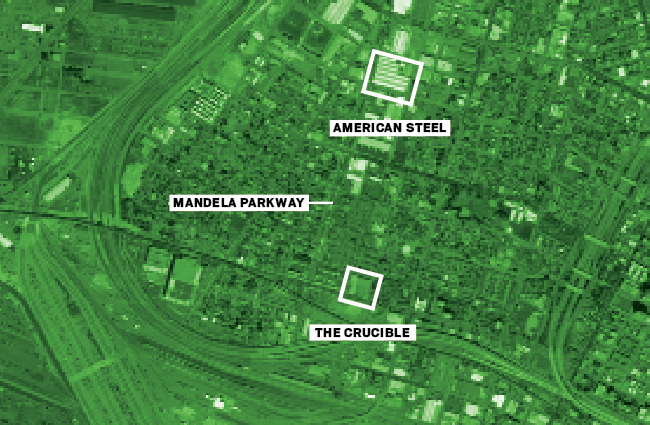
Courtesy Google 2013/TerraMetrics
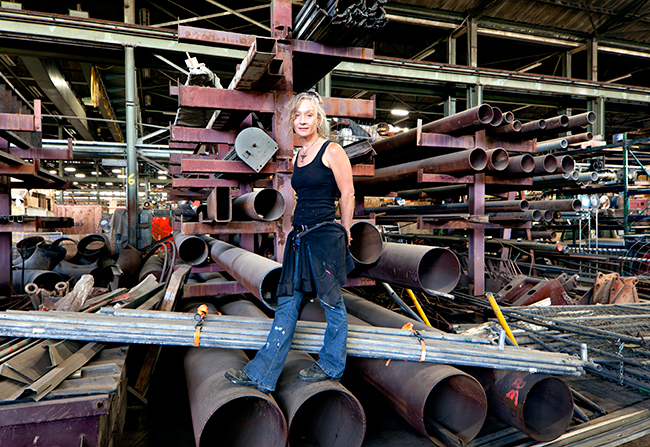
Karen Cusolito, the founder of American Steel Studios, stands amid her palette of scrap metal, from which she creates large-scale sculptures weighing up to 11 tons.
Henrik Kam
When Karen Cusolito came upon American Steel in 2005, the long-abandoned machinery was just what she needed to work on a 30-foot-tall sculptural commission. “At that point this building was primarily empty, and I could see from the exterior wall at 20th Street clear across to the exterior wall at 18th Street.” That year and the following one, the Rhode Island School of Design (RISD)–educated artist rented a portion of the building on a temporary basis, constructing towering female forms out of salvaged metal, which were exhibited at Burning Man and subsequently around the world. By 2007, she says, “Other artists and innovators became aware of the infrastructure of the space and realized it suited their needs, so I would lease a little more space and sublet to other artists.”
In 2009, Cusolito signed a lease on the entire six-acre property, thus becoming the founder of a significant landmark for the industrial arts. Today more than 150 artists and makers occupy the cavernous bays, which are filled with works in progress and material of all kinds, from the front halves of big-rig trucks to the extracted wooden remains of demolished homes. The open passage through the center of the building is lined with immense sculptures made from recycled metal, several of which are wired with propane-fueled fire effects. In one corner, the studio “break room” sits in a tiny cabin straight out of a Western mining town, providing 150 square feet of sound-insulated silence amid the sprawling din.
Artists come from around the world to work in this uniquely equipped space. New York artist Mike Ross is currently at work on a commission for Seattle’s newest light-rail station, featuring two decommissioned military jets meeting nose-to-nose above the tracks. The jets were delivered to American Steel by truck and took their “final flight,” as Cusolito put it, upon the hooks of the bridge cranes.
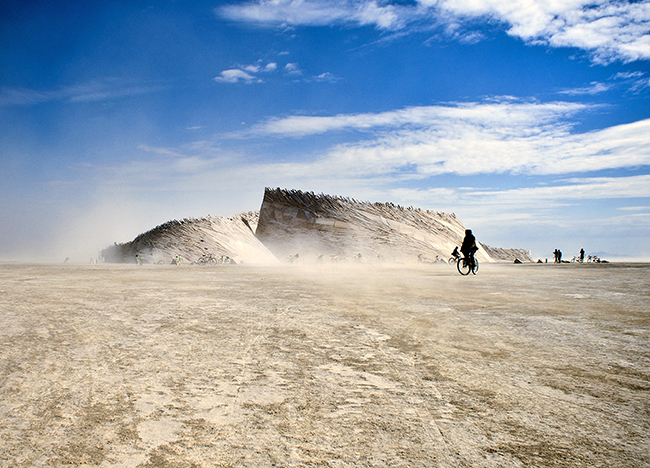
Temple of Flux by Flux Foundation, was a 21,000-square-foot art installation created for the 2010 Burning Man.
Courtesy Galen Stolee
Despite all this, unless you stumble upon American Steel on one of its open-studio evenings, when pyrotechnic sculptures are breathing fire and blaring bass, the impressive workings of this place go virtually unnoticed by the city at large. “A great deal of what’s being created is never seen in Oakland or even the Bay Area,” says Leslie Pritchett, a tenant at American Steel Studios and one of the most vocal advocates and organizers within the West Oakland industrial arts community. “A lot of what’s happening in this area is relatively opaque, and it has been to city administrators and many people who should know better.”
The only arts facility within this constellation that the city almost certainly does know about is the Crucible, a 47,000-square-foot building that sits at the southern end of Mandela Parkway. It was created as a nonprofit school where the public could learn some of the seldom-taught skills required to make industrial art: black-smithing, welding, glass blowing, and fire performance.
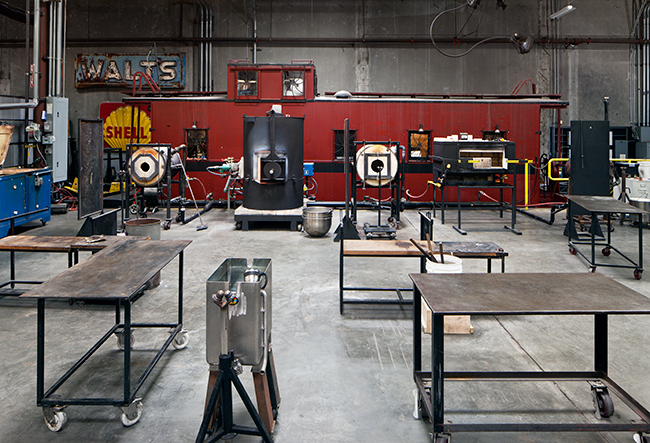
Inside the glass hot shop of the Crucible, where artists and students melt and shape their material.
Henrik Kam
The Crucible is in many ways ground zero for much of the fantastical art that makes its way to the Nevada desert each year for Burning Man, and indeed, the culture of the famous festival runs deep here, but it’s not the only focal point. Education is central. Executive director Steven Young works hard to publicize the school’s contribution to West Oakland’s youth enrichment. “We want to give young people an opportunity to participate in creative endeavors,” he says. “We all know that one of the problems in West Oakland is the lack of opportunities for young people to become inspired, get the skills they need, and have access to a variety of jobs.” Young has been actively pursuing foundation funding to support the Crucible’s educational initiatives. He and his cohorts along the corridor envision a program in which interns could acquire skills at the Crucible, then graduate to apprenticeships in fabrication at American Steel and elsewhere, eventually earning professional certificates.
In many ways the timing is perfect, as leaders in design and education, such as RISD’s president, John Maeda, encourage American schools to transform STEM curriculum (science, technology, engineering, and math) into STEAM, with the addition of art. Nowhere is it clearer than at these West Oakland institutions that disciplines such as technology and math are critical to the highly engineered art that comes out of the maker community.
Yet it takes effort to get this message across at the city level. While West Oakland artists are comfortable making noise in the production of their work, they’re rarely heard in the conversations most critical to influencing the future of the district. Historically, the city hasn’t taken them seriously as neighborhood anchors, and even less so as potential revenue drivers. Development plans often don’t factor artists into the equation, so it has fallen on Young, Cusolito, Pritchett, and other arts leaders to be bureaucratic liaisons, or face the possible condo-and-big-boxification of their neighborhood.
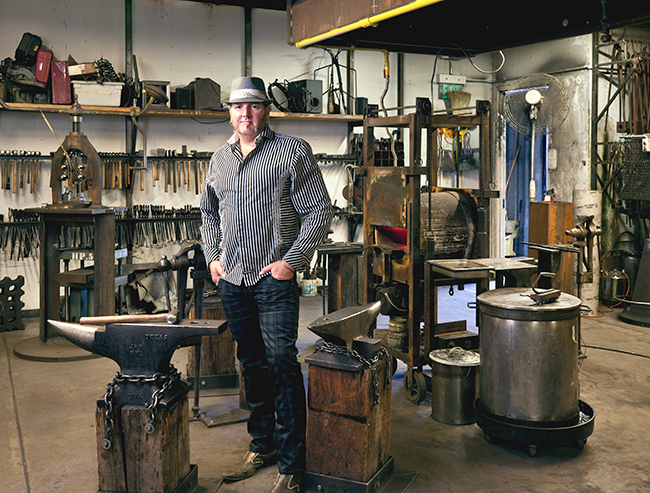
Steve Young, the executive director of the Crucible, is shown here in the blacksmithing studio. Young is currently seeking foundation support for a major expansion of the group’s neighborhood education program.
Henrik Kam
Several years ago Cusolito “commandeered a meeting” with the head of redevelopment at City Hall. “I said, ‘I don’t know if you’re aware of the assets you have here, but there are a lot of us and we have a lot of creative ideas.’” She presented an innovative proposal for reusing a portion of the soon-to-be defunct eastern Bay Bridge span as a pedestrian overpass along Mandela Parkway. “His jaw dropped,” Cusolito recalls, “He said, ‘Oh my god, that’s brilliant, you need to come to more of our meetings!’ And I said, ‘You need to invite us.’”
Like Williamsburg, Brooklyn in previous decades, West Oakland is uniquely positioned for growth. It is the first stop on the BART route out of downtown San Francisco, which means commuting is faster than coming in from outer neighborhoods of the city. Many ex-industrial buildings here, as in Brooklyn, possess the historic features that urban creatives pine for: thick, old brick; sky-high ceilings; giant windows; and few walls. They’re ripe for loft and condo conversions, and many were slated for residential rehab before the 2008 crash; Governor Jerry Brown then eliminated state redevelopment funds in 2011.
That said, there is not much money in this neighborhood, and there are few businesses to attract revenue and spur growth. West Oakland has no full-service grocery store, and no Wi-Fi-enabled coffee shops. From a retail and services perspective, it’s more Bushwick than Williamsburg, with just two destination eateries that draw diners from outside the neighborhood. Brown Sugar Kitchen, which occupies a prominent spot on Mandela Parkway, serves soul food to throngs of brunch-seekers throughout the week. But the eatery closes daily by 3 P.M., which leaves only the diminutive FuseBOX for dinner-hour possibilities.
Run by Korean-born Sunhui Chang and his African-American wife, Ellen, the 20-seat restaurant serves a thrillingly creative menu that marries Korean, American Southern, and Japanese traditions. Patrons have to track down the place along a shadowy side street, and sometimes they will find the family operation dark. Hours are regular with one exception: “Some Saturdays we are closed due to our daughter’s soccer tournaments,” says Sunhui Chang.
And yet despite the challenging location, FuseBOX survived past the one-year mark that many new restaurants strive for. A visit to one of its Sunday community meals makes clear the reason: this place is about family and neighborhood, two values West Oakland holds in high regard. There’s a lot of patience for the circumstances of daily life, and clear prioritization of authenticity above all.
If there’s any evidence needed that the industrial arts community isn’t composed of typical gentrifiers, this is probably it: More than 15 years into their tenancy here, the artists have not built any of the typical establishments that pop up when gentrification takes hold. But if they want to stay and preserve the kinds of spaces they currently inhabit, some kind of economic engine must be put in place. And while these aren’t your standard consumers of organic cupcakes and foam-art cappuccinos, they do want incoming businesses to prioritize local, artisan goods.
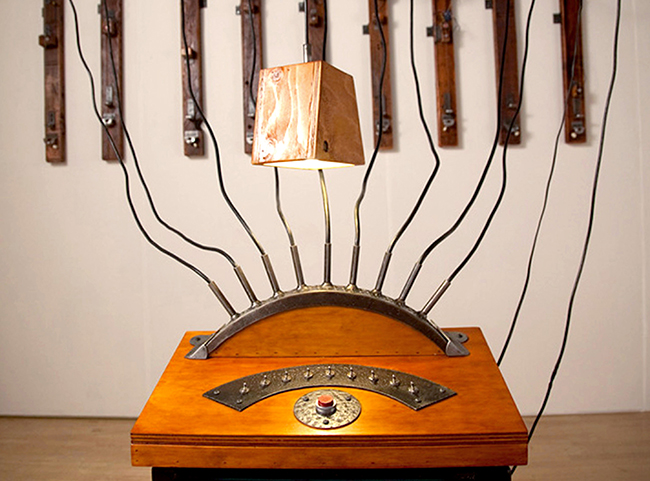
Population Flow by Benjamin Carpenter, an installation made of reclaimed old-growth wood and steel, expresses the daily growth in population through two layers of sound.
Courtesy Benjamin Carpenter
Given who’s here, the most obvious retail opportunity is in manufactured goods: products that are designed and fabricated nearby, and whose sale directly supports local people. West Oakland is a perfect candidate to become a hub for small-scale, custom manufacturing, with the infrastructure and potential workforce already in place. To push this vision forward, the artist community has organized Oakland Makers, a new entity with a three-fold mission: to increase the visibility of the city’s manufacturing and industrial arts; to sustain the ability of these sectors to thrive; and to grow a diverse local creative economy. The organization held a launch event at the end of May, where artists joined with representatives from the city to affirm their intention for arts-driven growth.
The gathering took place at another hidden gem of West Oakland, the studio and exhibition space of Bruce Beasley, a world-renowned abstract sculptor who at age 22 became the youngest artist ever acquired to the permanent collection at New York City’s MoMA. Now 74, Beasley is esteemed as a pioneer and father figure to the West Oakland creative population, having taken up residence here a half-century ago. Held in Beasley’s open-air courtyard on a cloudless afternoon, the Oakland Makers launch was not widely publicized, but the advocates who spoke in support of the initiative are stars of the international maker community. Next to the podium sat Chris Anderson, former editor-in-chief of Wired magazine, who quit his job to found a drone manufacturing company based in nearby Berkeley; and Dale Dougherty, cofounder of O’Reilly Media and founder of the Maker Faire. Young asked them, “Why Oakland now?”
Compared to San Francisco and Silicon Valley, Anderson said, Oakland has a unique set of conditions: “There’s high technology, access to a world-class university, a lower cost of doing business, and cultural diversity—to say nothing of the weather,” he explained. “You see more and more maker companies choosing to locate here.” Dougherty cited a recent article in the Los Angeles Times that called maker culture the Bay Area’s most important export. Just as Silicon Valley draws tech talent from around the world, Oakland can attract artists, designers, and engineers to its unique setting. “Think of the city as a magnet,” he encouraged.
City officials seem to be getting the picture. While not all interested parties agree on how to kick-start West Oakland, it’s clear that everyone expects development to happen soon, and the city claims it won’t happen at the expense of the existing cultural base. Kelley Kahn, the city’s new director of economic development, told the Oakland Makers supporters, “There’s something going on with the creative class here that is redefining Oakland. The story is no longer about public safety issues or cheaper space, but about innovation and creativity. I want to figure out how the city can support the maker movement, and leverage it for more investment and transformation.”
Planners estimate that in a decade or so, West Oakland will have more amenities elevating the quality of life. In order to signal progress, the planning department is looking to install a light-rail system over the next five years that would serve residents. “Most cities lost their trolleys in the 1950s and 1960s, and now we’re coming full circle,” says Rachel Flynn, director of planning and building for Oakland. “The neighborhood has a good grid system; we just need to fill in the missing pieces, put them right back where they were.”
No doubt battles still will be waged over how to fill things in—especially over building plans and zoning changes, which could limit the array of industrial activities permitted along the corridor. But at the Oakland Makers’ coming-out party, as bureaucrats chatted enthusiastically with neighborhood residents, it was clear that the city had at long last extended an invitation to the industrial artists of West Oakland.





